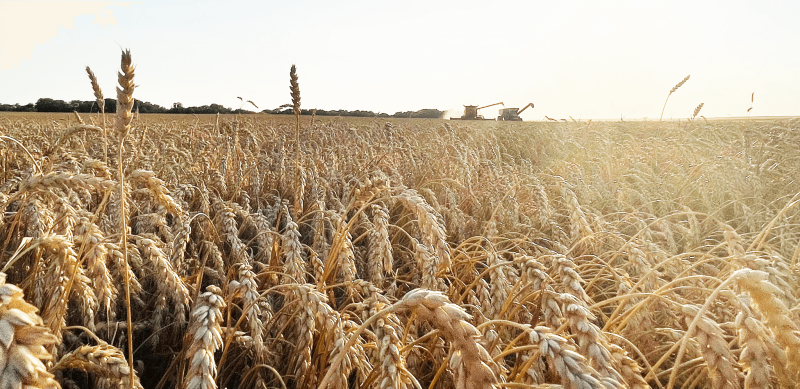How self fertilizing gene-edited wheat could be a boon for developing world farmers
How self fertilizing gene-edited wheat could be a boon for developing world farmers

Scientists at the University of California, Davis, have developed wheat plants that stimulate the production of their own fertilizer, opening the path toward less air and water pollution worldwide and lower costs for farmers.
The technology was pioneered by a team led by Eduardo Blumwald, a distinguished professor in the Department of Plant Sciences. The team used the gene-editing tool CRISPR to get wheat plants to produce more of one of their own naturally occurring chemicals. When the plant releases the excess chemical into the soil, the chemical helps certain bacteria in the soil convert nitrogen from the air into a form the nearby plants can use to grow. That conversion process is called nitrogen fixation.
The study was published online in Plant Biotechnology Journal.
In developing countries, the breakthrough could be a boon for food security.
…
Worldwide, wheat is the No. 2 cereal crop by yield and takes the biggest share of nitrogen fertilizer, using about 18% of the total. Globally, more than 800 million tons of fertilizer were produced in 2020 alone, according to figures from the United Nations Food and Agriculture Organization.
The addition of N-fertilisers to cereal crops contributes to enhanced food production, and more inorganic N-fertiliser will be needed to support a further increased food production required to satisfy the needs of an increasing world population (Omara et al. 2019). These additional inputs of N-fertilisers would make grain production more expensive, with a considerable aggravation in environmental pollution. Thus, there is a growing need to develop sustainable alternative agricultural practices aimed at reducing the excessive use of inorganic N-fertilisers.
…
A synthetic biology approach was used to create a plant-bacteria signalling circuit to improve N-fixation activity of bacteria associated with the roots of a target plant. Barley was engineered to produce scyllo-inosamine (SI), a rhizopine signalling molecule, and the bacterium Azorhizobium caulinodans was transformed to express a SI-uptake system (Haskett et al. 2022). This system allowed a tight rhizopine-dependent control of factors driving the expression and activity of the nitrogenase from bacteria colonising the barley roots.
…
[W]e demonstrated a novel experimental approach in which DNA from hexaploid wheat plants was modified to increase the production of a biofilm-stimulating metabolite. The apigenin exuded by the roots into the soil stimulated the formation of biofilms by the diazotrophic bacteria which protected the nitrogenase and induced biological nitrogen fixation. When grown at limiting N conditions, the modified wheat plants displayed increased growth and grain yield as compared to the control plants.This is an excerpt. Read the original post here
 | Videos | More... |

Video: Nuclear energy will destroy us? Global warming is an existential threat? Chemicals are massacring bees? Donate to the Green Industrial Complex!
 | Bees & Pollinators | More... |

GLP podcast: Science journalism is a mess. Here’s how to fix it

Mosquito massacre: Can we safely tackle malaria with a CRISPR gene drive?

Are we facing an ‘Insect Apocalypse’ caused by ‘intensive, industrial’ farming and agricultural chemicals? The media say yes; Science says ‘no’
 | Infographics | More... |

Infographic: Global regulatory and health research agencies on whether glyphosate causes cancer
 | GMO FAQs | More... |

Why is there controversy over GMO foods but not GMO drugs?

How are GMOs labeled around the world?

How does genetic engineering differ from conventional breeding?
 | GLP Profiles | More... |

Alex Jones: Right-wing conspiracy theorist stokes fear of GMOs, pesticides to sell ‘health supplements’





 Viewpoint — Fact checking MAHA mythmakers: How wellness influencers and RFK, Jr. undermine American science and health
Viewpoint — Fact checking MAHA mythmakers: How wellness influencers and RFK, Jr. undermine American science and health Viewpoint: Video — Big Solar is gobbling up productive agricultural land and hurting farmers yet providing little energy or sustainabilty gains
Viewpoint: Video — Big Solar is gobbling up productive agricultural land and hurting farmers yet providing little energy or sustainabilty gains Fighting deforestation with CO2: Biotechnology breakthrough creates sustainable palm oil alternative for cosmetics
Fighting deforestation with CO2: Biotechnology breakthrough creates sustainable palm oil alternative for cosmetics Trust issues: What happens when therapists use ChatGPT?
Trust issues: What happens when therapists use ChatGPT? California, Washington, Oregon forge immunization alliance to safeguard vaccine access against federal undermining
California, Washington, Oregon forge immunization alliance to safeguard vaccine access against federal undermining 30-year-old tomato line shows genetic resistance to devastating virus
30-year-old tomato line shows genetic resistance to devastating virus The free-range chicken dilemma: Better for birds, but with substantial costs
The free-range chicken dilemma: Better for birds, but with substantial costs ‘You have to treat the brain first’: Rethinking chronic pain with Sanjay Gupta
‘You have to treat the brain first’: Rethinking chronic pain with Sanjay Gupta
